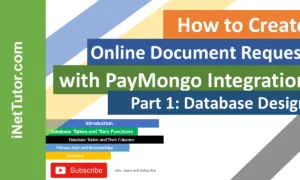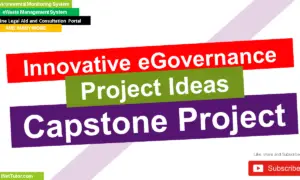Human-Computer Interaction HCI Capstone Project Ideas
Introduction
Table of Contents
Human-Computer Interaction (HCI) is the study of how people interact with computers and the design of user-friendly interfaces that make these interactions seamless and efficient. It combines principles from computer science, psychology, and design to create systems that are intuitive, accessible, and enjoyable to use. At its core, HCI focuses on understanding user needs, designing effective solutions, and evaluating their usability to ensure a positive user experience.
Capstone projects play a crucial role in the field of HCI by bridging the gap between theoretical knowledge and real-world application. These projects allow students and professionals to tackle complex problems, design innovative solutions, and test their ideas in practical scenarios. By working on capstone projects, individuals gain hands-on experience in user research, prototyping, usability testing, and iterative design—skills that are essential for a successful career in HCI.
Moreover, capstone projects often address real-world challenges, making a tangible impact on industries such as healthcare, education, and technology. They encourage creativity and innovation, pushing the boundaries of what’s possible in human-computer interaction. Whether it’s designing an accessible app for users with disabilities or creating an immersive AR experience, capstone projects empower individuals to develop solutions that improve lives and shape the future of technology.
20 Capstone Project Ideas
Below is a list of 20 original Human-Computer Interaction (HCI) Capstone Project Ideas, each with a brief description and suggested development tools. These ideas span accessibility, emerging tech, social impact, productivity, and entertainment, aligning with HCI principles of user-centered design and real-world impact.
- Voice-Controlled Recipe Assistant
- Description: A hands-free app for cooks, offering step-by-step recipe guidance via voice commands—perfect for multitasking in the kitchen.
- Development Tools: Python (speech recognition with libraries like SpeechRecognition), Flutter (cross-platform app), Google Cloud Speech-to-Text API.
- AR Study Buddy for Kids
- Description: An augmented reality app that overlays interactive 3D models (e.g., planets, animals) on textbooks to make learning fun and engaging.
- Development Tools: Unity (AR development), Vuforia (AR SDK), C#.
- Accessible Shopping App
- Description: A mobile app with screen reader support and simplified navigation for visually impaired users to shop online independently.
- Development Tools: React Native (mobile app), Firebase (backend), VoiceOver/Screen Reader testing.
- Emotion-Sensing Mental Health Chatbot
- Description: A chatbot that detects user emotions through text tone and offers tailored mindfulness exercises or support resources.
- Development Tools: Python (NLP with spaCy or NLTK), Dialogflow (chatbot framework), AWS for hosting.
- Gesture-Based Music Controller
- Description: A desktop app letting users control music playback (play, pause, skip) with hand gestures, ideal for hands-free environments.
- Development Tools: OpenCV (gesture recognition), Python, Spotify API.
- Eco-Tracker Dashboard
- Description: A web tool to track and visualize personal carbon footprints (e.g., energy, travel) with tips for sustainable living.
- Development Tools: JavaScript (React for frontend), Node.js (backend), Chart.js (data visualization).
- VR Therapy Room
- Description: A virtual reality space for anxiety relief, featuring calming environments and guided breathing exercises.
- Development Tools: Unity (VR development), Oculus SDK, Blender (3D modeling).
- Smart Task Prioritizer
- Description: An AI-driven app that learns user habits and prioritizes tasks with a clean, distraction-free interface.
- Development Tools: Python (machine learning with TensorFlow), Figma (UI prototyping), Electron (desktop app).
- Inclusive Video Call Translator
- Description: Real-time captioning and sign language translation for video calls to support hearing-impaired users.
- Development Tools: WebRTC (video streaming), Python (speech-to-text with Google API), TensorFlow (sign language detection).
- Interactive Storytelling Platform
- Description: A web app where users shape narratives through choices, with dynamic visuals and sound effects.
- Development Tools: JavaScript (React), Three.js (3D graphics), Firebase (data storage).
- Wearable Fitness Coach
- Description: A smartwatch app providing real-time workout feedback and adaptive goals based on user performance.
- Development Tools: Wear OS SDK, Android Studio, Fitbit API.
- Elderly Care Reminder System
- Description: A simple tablet interface with voice prompts for medication and appointment reminders, designed for seniors.
- Development Tools: Android Studio, Java, Google Text-to-Speech API.
- Collaborative Design Canvas
- Description: A web-based whiteboard for remote teams, with AI suggestions for organizing ideas and layouts.
- Development Tools: JavaScript (Vue.js), Socket.IO (real-time collaboration), TensorFlow.js (AI features).
- Haptic Gaming Controller
- Description: A custom controller with vibration feedback synced to in-game actions for a more immersive experience.
- Development Tools: Arduino (hardware), Unity (game integration), C++.
- Disaster Alert Community App
- Description: A mobile app delivering location-based emergency alerts and connecting users to local resources or volunteers.
- Development Tools: Flutter, Google Maps API, Firebase Cloud Messaging.
- Focus Mode Browser Extension
- Description: A tool to block distracting sites and gamify productivity with rewards for staying focused.
- Development Tools: JavaScript (Chrome Extension API), HTML/CSS for UI.
- AI Art Companion
- Description: An app that generates art prompts and critiques sketches based on user input, encouraging creativity.
- Development Tools: Python (AI with PyTorch), React Native, Cloudinary (image storage).
- Smart Mirror Interface
- Description: A mirror displaying weather, news, and daily schedules with touch or voice controls for home use.
- Development Tools: Raspberry Pi (hardware), JavaScript (Node.js), MagicMirror² framework.
- Sign Language Learning Game
- Description: A mobile game teaching sign language through interactive challenges and camera-based gesture tracking.
- Development Tools: Unity, OpenCV (gesture tracking), C#.
- Virtual Museum Guide
- Description: An AR app offering narrated tours and historical facts when users point their phone at exhibits.
- Development Tools: Unity, ARKit (iOS) or ARCore (Android), Photoshop (asset design).
These projects emphasize user experience (UX), leveraging intuitive design and modern tech to solve real problems. They’re scalable for capstone scope—start with a prototype and expand based on testing. Tools listed are accessible, widely used, and support iterative development, aligning with HCI’s focus on usability and feedback.
Tools and Technologies for HCI Projects
Human-Computer Interaction (HCI) projects thrive on tools that streamline design, development, and user testing. Whether you’re creating an accessible app or a VR experience, the right technologies ensure your project is user-friendly, functional, and impactful. Here’s a breakdown of essential tools and how they fit into HCI workflows.
- Design Tools
Design tools help craft visually appealing and intuitive interfaces—key to great HCI.
- Figma: A cloud-based, collaborative tool for designing interfaces with real-time teamwork. Perfect for wireframes, mockups, and pixel-perfect UI designs.
- Adobe XD: A powerful platform for designing and prototyping interactive interfaces with smooth animations and team-sharing features. Ideal for polished HCI visuals.
- Sketch: A macOS-exclusive tool loved for its simplicity in crafting vector-based UI designs. Great for lightweight, responsive layouts.
Use Case: Design a clean, accessible app interface for elderly users with large buttons and high-contrast colors.
- Prototyping Tools
Prototyping turns ideas into clickable, testable models to refine user experience early.
- InVision: A prototyping tool for creating interactive mockups and gathering feedback. Seamless integration with design tools speeds up iteration.
- Axure: A robust option for detailed, dynamic prototypes with conditional logic—perfect for complex HCI interactions like gesture controls.
- Balsamiq: A low-fidelity wireframing tool focused on quick, sketch-like prototypes to brainstorm and test basic layouts.
Use Case: Build a clickable prototype of a voice-activated shopping app to test navigation flow with users.
- Development Frameworks
Frameworks bring prototypes to life with code, enabling functional HCI solutions.
- React: A JavaScript library for building fast, interactive web interfaces. Its component-based structure suits scalable HCI projects like dashboards.
- Flutter: Google’s cross-platform framework for creating natively compiled apps for mobile, web, and desktop with a single codebase. Ideal for consistent UX across devices.
- Unity (for AR/VR): A game engine powerhouse for developing immersive augmented reality (AR) and virtual reality (VR) experiences, like therapy rooms or educational tools.
Use Case: Code an AR study app with Unity or a multi-device task manager with Flutter.
- Usability Testing Tools
Testing ensures your HCI project meets user needs through real feedback and analytics.
- UsabilityHub: A platform for quick user tests (e.g., preference tests, five-second tests) to validate design choices with minimal setup.
- Maze: A tool for remote usability testing on prototypes, offering heatmaps and user insights to optimize navigation and flow.
- Hotjar: A behavior analytics tool with heatmaps, session recordings, and surveys to see how users interact with your live interface.
Use Case: Use Maze to test a gesture-based music controller prototype and refine based on user click patterns.
Why These Tools Matter for HCI
These tools cover the HCI lifecycle—designing intuitive interfaces, prototyping for feedback, developing functional systems, and testing usability. They’re beginner-friendly yet powerful, making them perfect for capstone projects. Pair Figma with React for a sleek web app, or Unity with Hotjar to perfect a VR experience. Whatever your HCI goal, these technologies help deliver solutions that users love.
Conclusion
Human-Computer Interaction (HCI) plays a pivotal role in solving real-world problems by creating intuitive, accessible, and user-friendly interfaces that enhance the way people interact with technology. From improving accessibility for individuals with disabilities to designing immersive AR/VR experiences, HCI bridges the gap between humans and computers, making technology more inclusive and impactful.
Capstone projects in HCI provide a unique opportunity to apply theoretical knowledge to practical challenges, fostering innovation and creativity. By focusing on user-centered design, these projects not only address real-world needs but also empower students and professionals to develop solutions that can transform industries and improve lives.
The potential impact of well-executed HCI projects is immense. Whether it’s revolutionizing healthcare with wearable devices, enhancing education through gamified learning, or creating smarter environments with IoT, HCI projects have the power to shape the future of technology. By encouraging innovation and prioritizing user needs, we can continue to push the boundaries of what’s possible in human-computer interaction.
Let’s embrace the challenge of designing meaningful, user-centric solutions and make a lasting impact through HCI!
You may visit our Facebook page for more information, inquiries, and comments. Please subscribe also to our YouTube Channel to receive free capstone projects resources and computer programming tutorials.
Hire our team to do the project.

